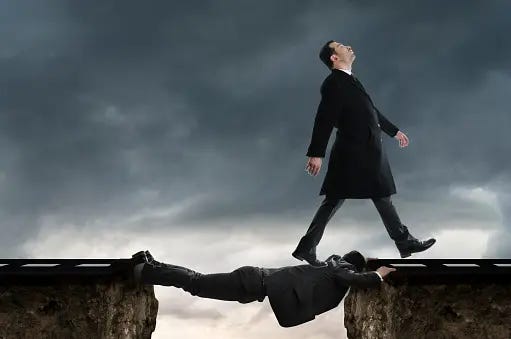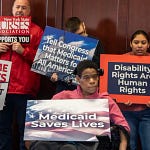This post goes out to both free and paid subscribers, but if you are not already a paid subscriber and value this effort and our growing community, please consider upgrading to a paid membership. But wait, there’s a sale going on at The Poverty Trap! For all NEW yearly Suscribers and NEW founding members, you will get 20% off if you sign up today through February 29, 2024. Thanks in advance for your financial support of my work —it’s what allows me to keep researching and writing.
“When asked what drives the economy, many Americans have a simple, single answer that comes to mind immediately: “greed.” They believe the rich and powerful have designed the economy to benefit themselves and have left others with too little or with nothing at all.” The New York Times, February 21, 2024
I was checking out at a grocery the other day during a time when almost no other customers were in the store. While the cashier was scanning my eight cans of a rare brand of cod pate (for my elderly cat), she was chatting with two other employees, one of whom was using a wheelchair. This woman was incredibly frustrated at her boss who kept scheduling her for too many work hours, even though she had told her many times that she was receiving disability payments and could not earn over a certain amount of money without cutting her benefits or losing them entirely.
I understand that being able to work full time and still receive full disability payments each month doesn’t make sense, but the government sets incredibly low limits on how much a disabled and/or poor person can earn and still receive benefits like disability payments, food stamps, health care and home heating and cooling assistance. And these limits are still based on antiquated notions of what amount of money it takes to survive in the United States today and what amounts the poor and disabled should be given, lest they get too comfortable.
The recent New YorkTimes opinion piece quoted above is written by two researchers and authors who both hold positions at the American Academy of Arts & Sciences. Catherine J. Kramer, who co-wrote the Times piece and was one of several authors of an extensive report for the Academy titled: “Reimagining Our Economy”1 suggests these “benefit cliffs” as they’re called, be modified to transition people to fully support themselves before 100% of the benefits are ripped away.
An example the researchers used is the earnings cut-off associated with Medicaid. In Kansas, the top amount a family of four can earn and still receive Medicaid is $39,900. I’m pretty sure with today’s cost of housing and groceries, a family of one couldn’t make it anywhere on just under $40,000, but earning even $1 more than $39,900 kicks that four-person family off of what is basically free health insurance. While the Affordable Care Act likely would provide premium subsidies, they would still have doctor visit and prescription co-pays, and a hefty deductible before insurance provided coverage.
If we want an economic system that is less “rigged” against the majority of Americans, the “Reimagining Our Economy” report provides a recommendation:
The Americans we listened to want resiliency so they can feel that they are in control of their lives and that they have a say in the direction of their community and their nation. They want a system focused less on how the economy is doing and more on how Americans are doing]. [Emphasis added].
The Poverty Trap has discussed the idea that our economy is purposefully skewed to favor corporations and wealthy individuals through its laws and policies. I explained in my “About” page and in numerous posts over the last two-plus years what I mean when I used the term “rigged”, and credit Senator Bernie Sanders and
for helping me better understand how our economic, political and legal systems are set up to benefit the wealthy and let the poor and middle class fend for themselves.Here’s a brief explanation about how the U.S. economy actually increases inequality, and the ramifications of these laws and policies from Nobel Laureate, Joseph E. Stiglitz. The video was published in 2018 by Scientific American.
“It’s very hard to have sustained growth without shared prosperity.” Joseph E. Stiglitz, 2001 winner of the Nobel Prize in Economics.
There are other ways, in addition to our reticence to help the poor, that our government’s policies not only condone but support inequality. Another issue that has been much discussed in recent years is the soaring pay gap between the CEO’s of major companies and those companies’ average workers.
According to a CBS News MoneyWatch report published in September of last year:
Back in the '60s and '70s, company executives earned "somewhere between 20 and 30 times" regular employees, but "that's massively increased, particularly in the 2000s," said Dambra .[Michael Dambra, an accounting and law professor at University at Buffalo].
Factoring in the nation's 350 largest companies, the CEO-to-worker pay ratio was 20-to-1 in 1965, according to the Economic Policy Institute. That figure jumped to 59-to-1 in 1989 and 399-to-1 in 2021, EPI researchers said. The CEO-to-worker pay ratio for S&P 500 firms was 186-to-1 in 2022, according to executive compensation research firm Equilar.
What’s startling about these statistics, particularly how CEO pay and benefits soared during the pandemic while many of us were hurting financially and depending on government help, is that during 2021 when the pay gap was at its highest and CEO’s were taking home a whopping 399 times more than their average worker, a cry rose from conservatives in general, and businesses in particular, to cut government aid to individuals. And that is exactly what happened.
Three types of expanded unemployment benefits ended in September of 2021 and were not renewed. In fact, many states, including Ohio, stopped the extra unemployment benefits several months before the program officially ended in early September, 2021, and returned the money to the federal government rather than allow unemployed workers a few extra bucks that were already allotted to them — and it wasn’t even the states’ money!
And we haven’t even touched the lopsided tax code that has for over half a century, allowed both corporations and the wealthiest individuals to pay a lower federal tax rate than their salaried employees, including the administrative assistants and secretaries without whom their businesses wouldn’t be able to function. Or taxpayer money that subsidizes every move corporations make, so they will be sufficiently incentivized to expand their businesses and create more low-paying jobs. On the other hand, those who represent business interests claim corporate subsidizes allow the government to nudge business in the direction it wants it to go, like creating lower cost housing and green energy alternatives. But to the tune of well over $100 billion annually?
So what can we do both individually and collectively to “unrig” our system and lessen the gap between the rich and everyone else? It starts with understanding the issues that affect our economy, like those discussed here, and then doing a little research on our current elected officials at every level. Where do they stand on these issues and what specific actions have they taken to “even the playing field” for those without substantial money or power? If their actions in office don’t line up with what we’ve learned is necessary to close the wealth gap, then vote them out, and vote in people with compassion and the smarts to see we all have to thrive, that sustained economic growth depends on shared prosperity, as the economist Joseph Stiglitz said. Together, we have to make it clear to our current elected officials, or the next generation we allow to govern us, that they and our government are here to serve and promote the common good, not special interests.
________________________________________________________
Do you think our economic system is “rigged” or purposely designed to benefit the wealthy and corporations at the expense of the rest of us? What can we do to level the playing field and close the wealth and inequality gap? Please share your thoughts in the Comment Section below—thanks!
And if you are not already a subscriber, don’t forget to sign up for a free subscription to The Poverty Trap and/or upgrade to paid! Don’t forget the 20% off sale only runs through February 29!
The American Academy report, published in November 2023, includes an amazing, interactive chart that allows you to see the economic security variables for each county in the United States: https://corescore.us/economic-security-2021-usa/quadrant_1/2021/00?demographic=education-high_school_graduate














Share this post